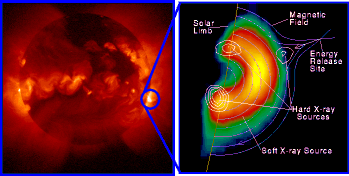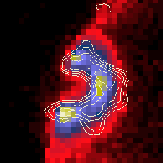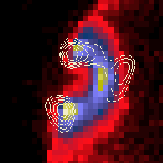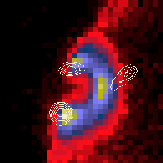 Image of the flare in soft and hard x-rays
Image of the flare in soft and hard x-raysThe left frame of the picture below shows a full-disk image of the Sun from the Yohkoh Soft X-ray Telescope (SXT). The right frame magnifies a flare that occurred on the west limb. A contour map of x-ray emission observed with the Hard X-ray Telescope (HXT) is superimposed on the soft x-ray intensity map.
 Image of the flare in soft and hard x-rays
Image of the flare in soft and hard x-rays
The structure of a flare can be quite complex, but SXT shows this one to have a
simple loop structure. The loop structure is common in the solar corona since
the coronal plasma is primarily confined to magnetic field lines that originate
from and loop back to the convection zone.
The hard x-rays are seen to originate from the two footpoints of the loop and from a compact region just above the top of the soft x-ray loop. The emission from the footpoints is an important confirmation of expectations from theoretical models developed before hard x-ray imaging became available. Energetic electrons accelerated in a flaring region will quickly stream along the magnetic field to the footpoints of the magnetic loop. The x-ray bremsstrahlung from these electrons will be greatest where the plasma is densest: low in the solar atmosphere, below the corona, at the location of the loop footpoints.
The compact hard x-ray source above the soft x-ray loop was unexpected. Its presence there indicates that the magnetic field structure must not be just a simple loop. The right frame of the above picture shows a field structure that accommodates this x-ray emission. A magnetic "cusp" contains the hard x-ray source. The diagram suggests that the electrons are not accelerated in the soft x-ray loop, but in the cusp above the loop. The field lines that continue above the cusp may eventually return to the Sun, or they may open up to the interplanetary medium. If they open to the interplanetary medium, they provide a direct route for energetic flare particles to escape the Sun.
This magnetic field configuration provides a location above the soft x-ray loop for the hard x-ray source, but it does not explain why it is located there. Why is it only at that location in the field configuration? Why is the entire loop not glowing in hard x-rays? What conditions are required for hard x-rays to be detected from this and only this location in the corona? A theoretical model designed to address these questions is described in subsequent pages of this web.
The contour maps below show the flaring loop in three of the Hard X-ray
Telescope's energy bands. As in the above picture, the hard x-ray contours are
superimposed upon an intensity map (color images) from the Soft X-ray
Telescope. At the lowest energies the entire soft x-ray loop is also bright in hard
x-rays. This is most likely bremsstrahlung from hot, thermal electrons in the
loop, although there may be some contribution from nonthermal electrons at the
footpoints. The coronal source is most distinct at the highest energies. The broad
energy bands of the Hard X-ray Telescope do not allow us to determine if the
emission is from thermal electrons or from accelerated, nonthermal electrons.
For the theoretical model described here we will assume that emission from the
coronal hard x-ray source originates from nonthermal electrons.
 |  |  |
14-23 keV | 23-33 keV | 33-53 keV |
![]()
![]() Next: A Model Flare Loop
Next: A Model Flare Loop
![]() Back: Why Study Solar Flares in Hard X-rays?
Back: Why Study Solar Flares in Hard X-rays?
![]() Solar Flare Homepage
Solar Flare Homepage
![]() Table of Contents
Table of Contents